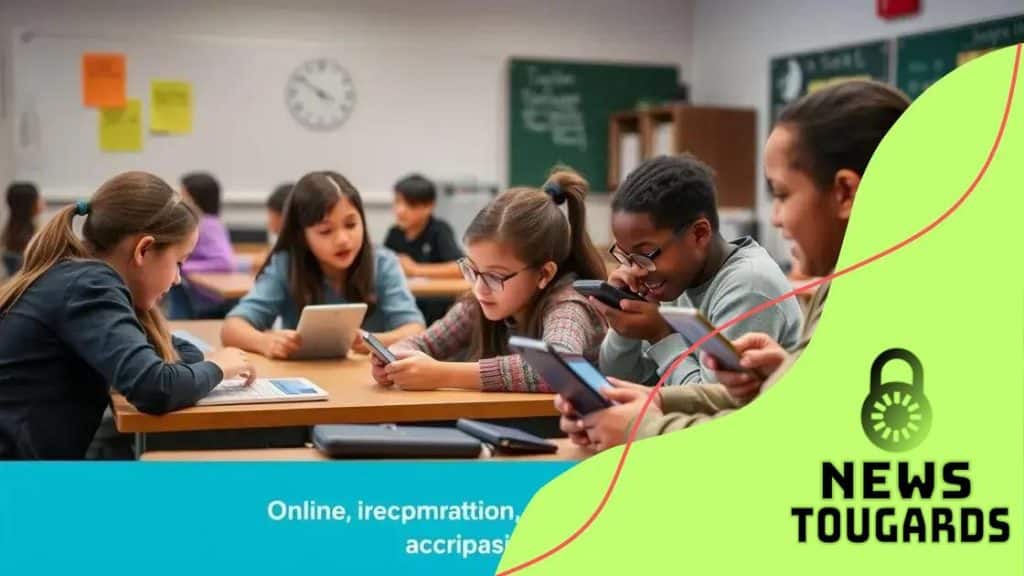Strategies for teaching digital citizenship in classrooms

Strategies for teaching digital citizenship in classrooms include using technology effectively, engaging students through interactive methods, and assessing their understanding to foster responsible online behavior.
Strategies for teaching digital citizenship in classrooms are essential for preparing students to navigate the digital world responsibly. Have you ever considered how your classroom can shape their online behavior? Let’s explore practical tips to ensure our students thrive online.
Understanding digital citizenship
Understanding digital citizenship is crucial in today’s technology-driven world. It involves knowing how to use digital tools responsibly and understanding the impact of our online actions. This concept teaches individuals to navigate the internet in a positive way, respecting others while protecting their own privacy.
Key components of digital citizenship
To grasp digital citizenship fully, it’s important to recognize its main components. These include:
- Online safety: Knowing how to protect personal information.
- Digital literacy: The ability to effectively use technology and understand online content.
- Responsible communication: Engaging with others respectfully and thoughtfully.
By emphasizing these elements, we prepare students to interact more skillfully in digital environments. Digital citizenship isn’t just a set of rules; it’s about fostering critical thinking and ethical behavior.
Benefits of understanding digital citizenship
Grasping the concept of digital citizenship has several advantages. Students who understand their rights and responsibilities online are more likely to:
- Respect others’ opinions: Encouraging healthy discussions.
- Avoid cyberbullying: Promoting a safer online community.
- Make informed choices: Helping them discern credible information.
Additionally, when students are well-versed in digital citizenship, they can navigate social media without falling into common traps, like misinformation. Ultimately, this knowledge shapes them into responsible digital citizens, prepared for the future.
Importance of teaching digital citizenship
The importance of teaching digital citizenship cannot be overstated in our technology-driven world. As students engage with digital devices, they face challenges that require an understanding of proper online conduct. Teaching them to navigate this landscape prepares them for responsible citizenship.
Benefits of digital citizenship education
Educating students about digital citizenship is essential for several reasons. It equips them with the skills needed to:
- Nurture respect: Understanding how to communicate respectfully online helps maintain a positive atmosphere.
- Prevent cyberbullying: Recognizing the signs of bullying can prevent harm to themselves and others.
- Find credible information: Developing critical thinking to assess sources is vital in combating misinformation.
Moreover, students learn the significance of their digital footprint. This awareness encourages them to think before sharing information, ultimately fostering a culture of responsibility.
Building a safe online environment
Teaching digital citizenship also contributes to creating safer online communities. When students understand their rights and responsibilities, they are less likely to engage in harmful behaviors. By promoting positive interactions, schools can cultivate a supportive network. Encouraging peer support is essential here, as students often rely on each other for guidance. This peer-to-peer teaching reinforces their understanding and application of digital citizenship in real-life scenarios.
Effective methods for classroom instruction

Utilizing effective methods for classroom instruction is essential to teach students about digital citizenship. Engaging teaching strategies not only capture students’ attention but also ensure they understand and apply digital citizenship principles in their lives.
Interactive Learning Activities
Implementing interactive learning activities fosters an engaging atmosphere. For instance, group discussions allow students to share experiences and ideas, promoting a deeper understanding of digital issues.
- Role-playing scenarios: Students can act out various situations online, helping them practice responses to certain behaviors.
- Collaborative projects: Working together on digital projects encourages teamwork and communication.
- Digital debates: Engaging in debates about online topics sharpens critical thinking skills.
Such methods keep students active and involved, making learning about digital citizenship more relatable.
Incorporating Technology
Technology integration is key in modern classrooms. Using multimedia presentations and online resources enriches the learning experience. For example, video clips can illustrate concepts clearly and effectively.
In addition, using educational platforms allows teachers to create interactive lessons. These platforms often include quizzes and polls that help gauge student understanding in real time. Students also appreciate using digital tools to create content, enabling them to express their ideas creatively.
As students interact with technology, they learn to use it responsibly. This experience is invaluable as they explore the challenges of digital life today.
Incorporating technology into lessons
Incorporating technology into lessons is essential for teaching digital citizenship effectively. Technology can transform traditional learning environments, making them more interactive and engaging for students.
Utilizing Digital Tools
Teachers can use various digital tools to enhance their lessons. For instance, online research activities encourage students to explore credible sources, helping them understand how to assess information quality.
- Interactive presentations: Tools like PowerPoint or Google Slides allow students to create engaging presentations on digital citizenship topics.
- Educational apps: Apps focused on digital literacy can provide fun exercises and quizzes that reinforce learning.
- Video tutorials: Short videos can illustrate important digital concepts, making them easier to grasp.
By leveraging these tools, educators can create a dynamic classroom environment that motivates students to learn.
Engaging with Multimedia
Incorporating multimedia into lessons is another effective strategy. Teachers can showcase videos, infographics, and podcasts that cover various digital citizenship themes. These resources help to simplify complex ideas and make learning enjoyable.
Furthermore, using social media responsibly can be explored through classroom projects. Students can create campaigns or blogs that focus on digital citizenship issues, allowing them to practice positive online behavior. This hands-on approach encourages creativity while reinforcing essential digital skills.
Overall, merging technology with traditional teaching methods fosters a rich learning experience that better prepares students for the digital age.
Assessing students’ digital citizenship skills
Assessing students’ digital citizenship skills is essential to ensure they understand and apply what they learn. Effective assessment methods provide insight into their ability to navigate the digital world responsibly. Teachers can utilize a variety of approaches to evaluate these skills accurately.
Methods of Assessment
One way to assess digital citizenship skills is through projects that require students to demonstrate their understanding. For example, they can create presentations or reports on specific digital topics. Teachers can look for:
- Understanding of online safety: Assess if students can identify safe practices.
- Ability to assess information: Evaluate whether they can discern credible sources from unreliable ones.
- Commitment to respectful communication: Observe how students engage in discussions.
These projects allow students to showcase their learning creatively.
Engaging Digital Assessments
Digital platforms also offer unique ways to assess students’ skills. Online quizzes and surveys can provide immediate feedback, which is helpful in gauging understanding. Additionally, students can participate in peer assessments, where they evaluate each other’s work related to digital citizenship.
Self-assessment can be valuable as well. Encouraging students to reflect on their own online behaviors and decisions helps build self-awareness, which is a key part of being a responsible digital citizen. By combining these assessment methods, teachers can create a comprehensive picture of a student’s digital citizenship capabilities.
FAQ – Frequently Asked Questions about Teaching Digital Citizenship
What is digital citizenship?
Digital citizenship refers to the responsible use of technology and the internet, including understanding rights, responsibilities, and how to engage positively online.
Why is teaching digital citizenship important in schools?
Teaching digital citizenship helps students navigate the digital world safely and responsibly, preparing them for future challenges and promoting a positive online community.
What are effective methods for teaching digital citizenship?
Effective methods include interactive activities, incorporating technology into lessons, project-based learning, and using assessments to gauge understanding.
How can I assess students’ digital citizenship skills?
You can assess students through projects, quizzes, peer evaluations, and self-assessment techniques that encourage reflection on their online behavior.





